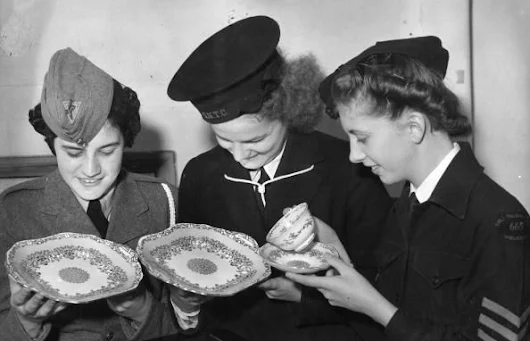https://www.youtube.com/watch?v=_joiOHyojKo
The National Association of Training Corps for Girls was formed in 1940 and was the umbrella organisation for the Girls Training Corps (GTC), Girls' Nautical Training Corps (GNTC) and Women's Junior Air Corps (WJAC).
https://youtu.be/SWMOUWV_w0M?t=44s
http://www.bbc.co.uk/history/ww2peopleswar/stories/48/a1944948.shtml
Girls Training Corps. This was a national organisation whose aim was to offer instruction to girls [between the ages of 14 and 18] in the skills which they would need if and when they joined the services. So we learnt the Morse Code from an instructor who was based at a local army camp, some aircraft recognition, map reading, took army drill instruction and assisted the Air Raid wardens on their rounds. We were issued with a uniform which was best described as ‘functional’!
All of this was somehow fitted in at weekends or in the evenings after work.
The Air Training Corps was already well established for young boys and with similar aims.
http://www.bbc.co.uk/history/ww2peopleswar/stories/87/a7274487.shtml
In 1942, the Girls' Naval Training Corps was formed as part of the National Association of Training Corps for Girls, with Units mainly in southern England. Its objective was congruent with that of the Sea Cadet Corps, teaching girls the same seamanship skills as the SCC taught the boys.
https://en.wikipedia.org/wiki/Girls%27_Nautical_Training_Corps
https://wikivisually.com/wiki/Sea_Cadets_(disambiguation)
The National Association of Training Corps for Girls was formed as the umbrella organisation responsible for the GTC (Girls Training Corps) GNTC (Girls Nautical Corps) and the WJAC (Women’s Junior Air Corps) later on after the war the GTC and WJAC amalgamated to become the Girls Venture Corps. The GTC was disbanded and wound up in 1948. The main reason being that after the war there seemed to be a lack of interest, need and motivation.
Their uniform consisted of Black shoes, Navy skirt, White blouse, Navy tie, GTC badge and Navy forage hat/ chip bag hat. School playgrounds became their parade ground; company 646 used Somercotes Infants School. They became proficient in marching, often displaying this on parades through the streets. Many of the groups had a Sergeant Major training them. For exercises and keep fit they had a PE Teacher. Somercotes PE Teacher was Doug Barrett, My Step mum who is now 92 remembers him well. Typical training was on homemaking, craftsmanship, public affairs. Lectures were given by the Red Cross on home nursing, first aid, practical bed making, ambulance work, stretcher bearing and sanitation. They were also taught leadership skills, etiquette, and an insight into local government, map reading and Morse code to enable them to deliver messages on their push bikes in time of War or in the event of invasion. They were apparently even trained to fire a rifle.
http://www.somercoteshistory.co.uk/ww2featured.asp


